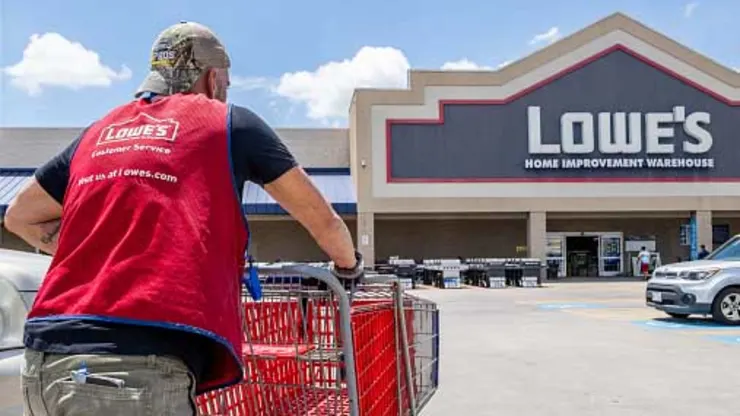Lowe’s cut its full-year outlook Tuesday, as lumber prices fell, unfavorable weather hurt demand for seasonal merchandise and do-it-yourself customers bought fewer big-ticket items.
Shares of the company closed nearly 2% higher Tuesday, however, as the retailer beat Wall Street’s revenue and earnings expectations for the fiscal first quarter.
On a call with investors, CEO Marvin Ellison said the company expects “a pullback in discretionary consumer spending over the near term.”
Yet Lowe’s is in a better spot than other retailers, he said. Two-thirds of its sales come from nondiscretionary purchases, such as new appliances to replace broken ones.
U.S. housing stock is aging, which drives more repairs and other projects. And as days become sunnier and warmer, sales of spring categories are rebounding, he said.
“Although we can’t predict the duration of what we think will be a more short-term turbulence, we think the medium and long-term health of this segment is incredibly strong,” he said.
Ellison said the company has not seen a change in demand in markets where rising interest rates have contributed to cooling home prices. He declined to share details on May sales trends, but said they are in line with company guidance.
Here’s what the company reported for the three-month period ended May 5 compared with what Wall Street was expecting, based on a survey of analysts by Refinitiv:
- Earnings per share: $3.67 adjusted vs. $3.44 expected
- Revenue: $22.35 billion vs. $21.6 billion expected
Lowe’s net income for the three-month period was $2.26 billion, or $3.77 per share, compared with $2.33 billion, or $3.51 per share, a year earlier.
Net sales fell nearly 6% to $22.35 billion from $23.66 billion in the year-ago period, but exceeded Wall Street’s expectations.
Comparable sales dropped 4.3% in the fiscal first quarter. That’s lower than the 3.4% decline that Wall Street expected, according to StreetAccount.
Lowe’s is the latest retailer to warn of slower sales ahead, as consumers become thriftier and reluctant to spend on discretionary items. Many other retailers, including Walmart, Target and Home Depot, also noticed fewer purchases outside of the necessities.
Lowe’s said it now expects total sales for the full year to range between $87 billion and $89 billion, lower than the $88 billion to $90 billion it had previously forecast. It said it projects comparable sales to decline by 2% to 4% this fiscal year, below the flat to down 2% that it had said before.
It said adjusted earnings per share will range between $13.20 and $13.60, below its previous range of $13.60 to $14.00.
For Lowe’s and Home Depot, however, the time of year adds significance. Spring is the biggest sales season for home improvement.
The companies are not only competing for shoppers’ dollars as higher prices for groceries and more take up more of household budgets. They also are dealing with a shift in demand, as the spree of Covid pandemic-fueled home projects fades and consumers juggle other spending priorities, such as commutes, summer vacations and meals at restaurants.
Lowe’s competitor, Home Depot, posted a revenue miss with its quarterly report last week. The company missed sales expectations for the second consecutive quarter and cut its full-year forecast, as customers skipped big-ticket items like grills and opted for smaller, less expensive home projects.
Like Lowe’s, Home Depot also chalked up lower sales to colder and wetter weather in the western U.S. and falling lumber prices.
Lowe’s and Home Depot, however, have a different mix of sales. About 75% of Lowe’s sales come from DIY customers, while Home Depot typically gets about half of its sales from home professionals.
Led by Ellison, Lowe’s has courted home professionals, who tend to be a steadier source of business, less sensitive to bad weather and more likely to complete a project. It has relaunched its loyalty program for those plumbers, contractors and electricians and played catchup with website improvements.
E-commerce was one of the quarter’s strengths. Online sales grew 6% compared with the year-ago period, as home pros shopped on the company’s website and DIY customers used digital tools to help them visualize and estimate before tackling a project, Ellison said on the call.
Comparable sales to home professionals rose in the first quarter compared with the year-ago period, too. However, most of Lowe’s business — roughly 75% — comes from DIY customers.
Lowe’s overall comparable sales were negative every month of the quarter, but the sharpest year-over-year drop came in March, as the metric declined 5.4%, CFO Brandon Sink said. Comparable sales fell 3% in February and dropped 3.9% in April. He attributed the decrease in March and April to unfavorable weather.
Sink said Lowe’s expects sales from pros to outpace those from DIY shoppers for the rest of the year. Professionals have a healthy backlog of jobs and still see demand from customers, he said.
The retailer also chased new sales opportunities in rural areas during the quarter. At some stores, it has expanded the mix of merchandise to add more apparel and farm or ranch-type items that have higher profit margins. In some of those markets, Lowe’s competes with other players including Tractor Supply.
Shares of Lowe’s closed Monday at $203.15, bringing the company’s market value to $121.15 billion. Its stock is up nearly 2% so far this year, trailing the S&P 500′s gains of 9%.

